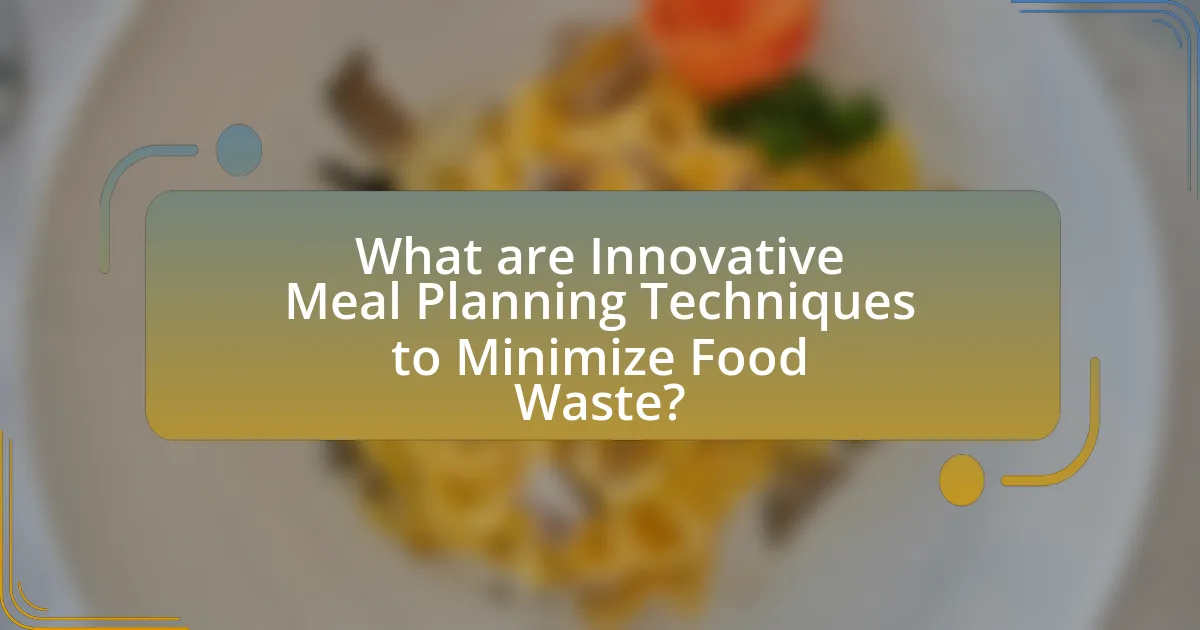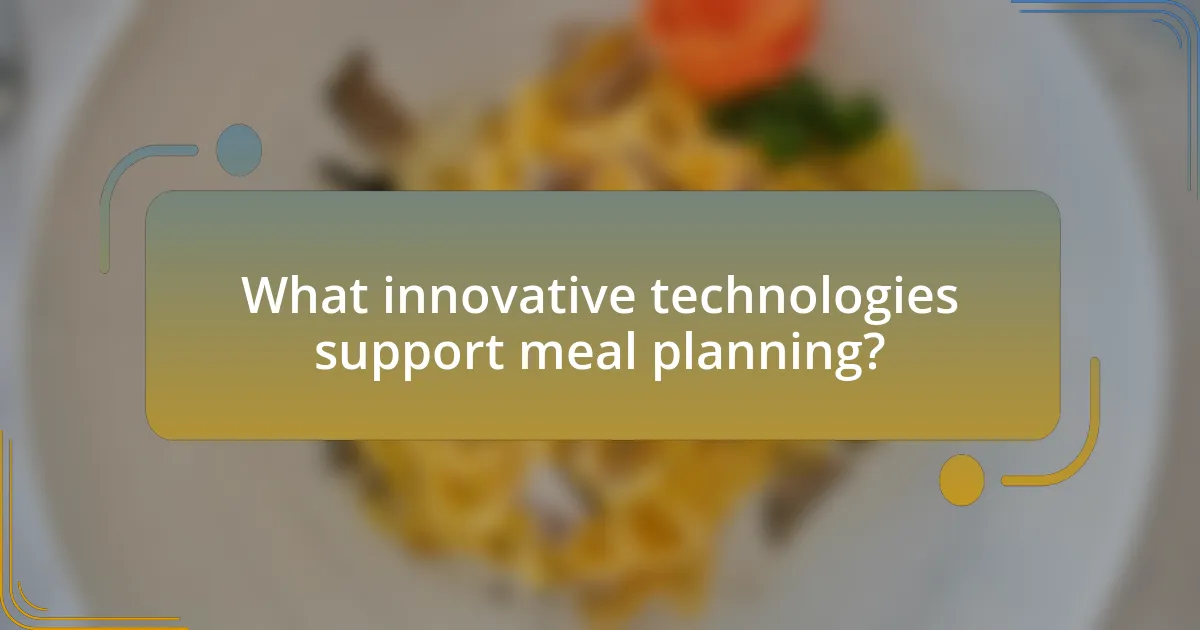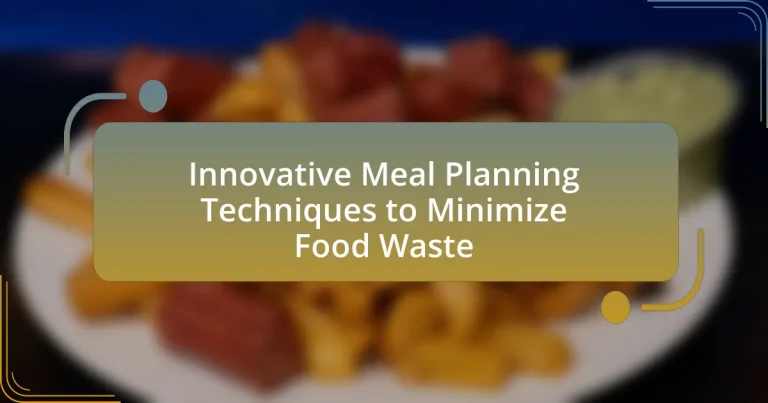The article focuses on innovative meal planning techniques aimed at minimizing food waste. It highlights strategies such as batch cooking, flexible meal scheduling, and inventory management systems, which can significantly reduce food waste by optimizing ingredient usage and enhancing meal preparation efficiency. The discussion includes the environmental and economic impacts of food waste, the importance of effective meal planning components, and the role of technology and community initiatives in promoting sustainable eating habits. Practical tips for individuals to implement these techniques are also provided, emphasizing the need for mindful consumption and resource conservation.

What are Innovative Meal Planning Techniques to Minimize Food Waste?
Innovative meal planning techniques to minimize food waste include utilizing batch cooking, implementing a flexible meal schedule, and employing inventory management systems. Batch cooking allows individuals to prepare large quantities of meals at once, which can be portioned and frozen for later use, reducing the likelihood of spoilage. A flexible meal schedule encourages the use of ingredients based on their ripeness or expiration dates, ensuring that food is consumed before it goes bad. Inventory management systems, such as keeping a running list of pantry items and their expiration dates, help in planning meals around what is already available, thereby minimizing unnecessary purchases and waste. These techniques are supported by studies indicating that effective meal planning can reduce food waste by up to 50%.
How do these techniques contribute to reducing food waste?
Innovative meal planning techniques contribute to reducing food waste by optimizing ingredient usage and enhancing meal preparation efficiency. These techniques, such as inventory management, portion control, and flexible recipes, ensure that ingredients are used before they spoil, thereby minimizing excess. For instance, studies indicate that households employing meal planning reduce food waste by up to 50%, as they are less likely to purchase unnecessary items and can better utilize what they already have. This strategic approach not only conserves resources but also promotes sustainable consumption practices.
What specific strategies are included in innovative meal planning?
Innovative meal planning includes strategies such as batch cooking, utilizing seasonal ingredients, and implementing a flexible menu system. Batch cooking allows for the preparation of large quantities of food at once, reducing cooking time and minimizing food waste by ensuring that leftovers are consumed. Utilizing seasonal ingredients not only enhances flavor but also supports local agriculture and reduces the carbon footprint associated with transporting out-of-season produce. A flexible menu system encourages adaptability based on available ingredients, which helps in using up items before they spoil. These strategies collectively contribute to minimizing food waste while promoting efficient meal preparation.
How do these strategies differ from traditional meal planning methods?
Innovative meal planning strategies differ from traditional methods by focusing on reducing food waste through dynamic and flexible approaches. Traditional meal planning often relies on rigid weekly menus and bulk purchasing, which can lead to excess food that may spoil. In contrast, innovative techniques utilize real-time inventory management, seasonal ingredient selection, and adaptive recipes that adjust based on available ingredients, thereby minimizing waste. For example, a study published in the Journal of Cleaner Production found that households employing flexible meal planning reduced food waste by up to 30% compared to those using conventional methods.
Why is minimizing food waste important?
Minimizing food waste is important because it conserves resources, reduces greenhouse gas emissions, and addresses food insecurity. Food waste accounts for approximately 30-40% of the food supply in the United States, leading to the waste of water, energy, and labor used in food production. Additionally, when food decomposes in landfills, it generates methane, a potent greenhouse gas that contributes to climate change. By reducing food waste, we can improve resource efficiency and help ensure that more food is available for those in need, thereby tackling hunger and promoting sustainability.
What environmental impacts are associated with food waste?
Food waste significantly contributes to environmental degradation, primarily through greenhouse gas emissions. When food waste decomposes in landfills, it produces methane, a potent greenhouse gas that is 25 times more effective at trapping heat in the atmosphere than carbon dioxide over a 100-year period. According to the Food and Agriculture Organization, approximately 1.3 billion tons of food are wasted globally each year, leading to an estimated 3.3 billion tons of greenhouse gas emissions. Additionally, food waste exacerbates resource depletion, as it involves the unnecessary use of water, land, and energy for production, transportation, and storage of food that is ultimately discarded. This inefficiency strains ecosystems and contributes to biodiversity loss.
How does food waste affect economic factors for households?
Food waste significantly impacts economic factors for households by increasing food expenses and reducing overall financial efficiency. Households waste approximately 30-40% of the food they purchase, leading to an annual loss of around $1,500 for a family of four in the United States. This wasted food represents not only the cost of the food itself but also the resources used in its production, transportation, and disposal, which further strains household budgets. By implementing innovative meal planning techniques, such as creating shopping lists based on meal prep and utilizing leftovers, households can minimize waste and enhance their economic stability.

What are the key components of effective meal planning?
The key components of effective meal planning include setting clear goals, creating a balanced menu, organizing shopping lists, and utilizing proper storage techniques. Setting clear goals helps individuals define dietary needs and preferences, which can lead to healthier eating habits. Creating a balanced menu ensures that meals include a variety of food groups, promoting nutritional adequacy. Organizing shopping lists based on the planned menu minimizes impulse purchases and reduces food waste. Utilizing proper storage techniques, such as freezing leftovers and using airtight containers, extends the shelf life of ingredients and prepared meals, further decreasing waste. These components collectively enhance meal planning efficiency and effectiveness.
How can meal prep help in minimizing food waste?
Meal prep helps minimize food waste by allowing individuals to plan and portion meals in advance, ensuring that ingredients are used efficiently and reducing the likelihood of spoilage. By preparing meals ahead of time, people can utilize perishable items before they expire, which is supported by research indicating that meal planning can lead to a 30% reduction in food waste. This proactive approach not only optimizes ingredient usage but also encourages mindful consumption, ultimately contributing to a decrease in overall food waste.
What are the best practices for meal prepping?
The best practices for meal prepping include planning meals in advance, using proper storage techniques, and incorporating a variety of ingredients. Planning meals allows individuals to create a shopping list that minimizes food waste by ensuring only necessary items are purchased. Proper storage techniques, such as using airtight containers and labeling meals with dates, help maintain freshness and prevent spoilage. Incorporating a variety of ingredients not only enhances nutritional value but also keeps meals interesting, reducing the likelihood of food being discarded due to lack of appeal. These practices collectively contribute to efficient meal prepping and effective food waste reduction.
How does portion control play a role in meal prep?
Portion control is essential in meal prep as it helps manage food quantities, reducing waste and promoting balanced nutrition. By preparing meals in specific portion sizes, individuals can ensure they consume appropriate amounts of food, which aligns with dietary guidelines and prevents overeating. Research indicates that proper portion sizes can lead to a decrease in food waste; for instance, a study published in the Journal of Nutrition found that individuals who practiced portion control wasted 20% less food compared to those who did not. This practice not only supports healthier eating habits but also contributes to sustainability by minimizing excess food that would otherwise go uneaten.
What role does inventory management play in meal planning?
Inventory management is crucial in meal planning as it ensures the efficient use of ingredients, reducing food waste. By tracking available food items, meal planners can create menus that utilize existing inventory, preventing over-purchasing and spoilage. Research indicates that effective inventory management can lead to a 20-30% reduction in food waste, as it allows for better forecasting of needs and timely use of perishable items. This systematic approach not only optimizes resources but also contributes to sustainability in food consumption.
How can tracking pantry items reduce food waste?
Tracking pantry items can significantly reduce food waste by enabling individuals to monitor expiration dates and inventory levels. This practice allows consumers to plan meals based on what they already have, preventing the purchase of unnecessary items that may go unused. According to a study by the Food Waste Reduction Alliance, approximately 40% of food in the United States is wasted, often due to overbuying and lack of awareness about existing pantry contents. By keeping an accurate record of pantry items, households can make informed decisions, utilize ingredients before they spoil, and ultimately decrease the amount of food discarded.
What tools can assist in effective inventory management?
Effective inventory management can be assisted by tools such as inventory management software, barcode scanning systems, and demand forecasting tools. Inventory management software, like TradeGecko or Fishbowl, enables businesses to track stock levels, orders, and sales in real-time, improving accuracy and efficiency. Barcode scanning systems streamline the process of tracking inventory by automating data entry, reducing human error. Demand forecasting tools, such as NetSuite or SAP Integrated Business Planning, analyze historical sales data to predict future inventory needs, helping to minimize overstock and stockouts. These tools collectively enhance inventory accuracy, reduce waste, and optimize stock levels, which is crucial for minimizing food waste in meal planning.

What innovative technologies support meal planning?
Innovative technologies that support meal planning include mobile applications, artificial intelligence, and smart kitchen appliances. Mobile applications like Mealime and Yummly allow users to create personalized meal plans based on dietary preferences and available ingredients, streamlining the planning process. Artificial intelligence enhances meal planning by analyzing user data to suggest recipes and optimize grocery lists, reducing food waste by ensuring that ingredients are used efficiently. Smart kitchen appliances, such as connected refrigerators, can track inventory and expiration dates, alerting users when items need to be used, thus minimizing waste. These technologies collectively improve meal planning efficiency and sustainability.
How can apps and software enhance meal planning efficiency?
Apps and software enhance meal planning efficiency by automating grocery lists, providing recipe suggestions based on available ingredients, and tracking food inventory. These digital tools streamline the meal preparation process, allowing users to save time and reduce food waste. For instance, a study by the Food Waste Reduction Alliance indicates that meal planning can reduce food waste by up to 30%, as it encourages users to purchase only what they need. Additionally, apps like Mealime and Yummly offer personalized meal plans that cater to dietary preferences, further optimizing the planning process and minimizing unnecessary purchases.
What features should one look for in meal planning apps?
Meal planning apps should include features such as recipe suggestions, grocery list generation, nutritional tracking, and meal prep scheduling. Recipe suggestions help users discover meals based on available ingredients, reducing food waste by utilizing what is already on hand. Grocery list generation streamlines shopping by organizing needed items, which can prevent over-purchasing. Nutritional tracking allows users to monitor their dietary intake, promoting healthier eating habits. Meal prep scheduling assists in organizing cooking times and methods, ensuring that meals are prepared efficiently and consumed before spoilage occurs. These features collectively enhance the effectiveness of meal planning apps in minimizing food waste.
How do these technologies help in tracking food usage?
Technologies such as IoT devices, mobile applications, and data analytics significantly enhance the tracking of food usage by providing real-time monitoring and insights into consumption patterns. IoT devices can monitor inventory levels and expiration dates, allowing users to receive alerts when food items are nearing spoilage. Mobile applications enable users to log their food purchases and consumption, offering personalized recommendations based on their eating habits. Data analytics processes this information to identify trends and suggest meal plans that optimize food usage, thereby reducing waste. For instance, a study by the Food Waste Reduction Alliance found that using technology to track food usage can lead to a 20-30% reduction in food waste in households.
What are some community initiatives that promote innovative meal planning?
Community initiatives that promote innovative meal planning include food co-ops, community gardens, and meal-sharing programs. Food co-ops often provide members with access to bulk purchasing options, which encourages planning meals around seasonal and local produce, thereby reducing food waste. Community gardens allow residents to grow their own food, fostering a connection to ingredients and promoting meal planning based on what is harvested. Meal-sharing programs, such as those organized by local nonprofits, encourage individuals to prepare and share meals, which can lead to more efficient use of ingredients and less waste. These initiatives have been shown to enhance community engagement and awareness around food sustainability, as evidenced by studies highlighting increased participation in local food systems and reduced food waste in participating households.
How do local programs encourage sustainable eating habits?
Local programs encourage sustainable eating habits by promoting community engagement and education on food sourcing and preparation. These programs often provide workshops that teach individuals how to select seasonal produce, which reduces carbon footprints associated with transportation. For example, community-supported agriculture (CSA) initiatives connect consumers directly with local farmers, fostering a preference for locally grown foods. Research indicates that participants in such programs are more likely to adopt sustainable practices, as evidenced by a study published in the Journal of Agricultural and Environmental Ethics, which found that 70% of CSA members reported increased awareness of sustainable eating habits.
What resources are available for individuals to learn about meal planning?
Individuals can learn about meal planning through various resources such as online courses, cookbooks, meal planning apps, and websites dedicated to nutrition and cooking. Online platforms like Coursera and Udemy offer structured courses on meal planning, while cookbooks provide practical recipes and tips. Meal planning apps like Mealime and Paprika help users organize their meals and shopping lists efficiently. Websites such as the USDA’s ChooseMyPlate.gov offer guidelines and resources for balanced meal planning, emphasizing the importance of minimizing food waste through proper planning and storage techniques.
What practical tips can individuals implement to minimize food waste through meal planning?
Individuals can minimize food waste through meal planning by creating a detailed shopping list based on planned meals, which helps avoid impulse purchases and ensures that only necessary items are bought. This approach is supported by research indicating that structured meal planning can reduce food waste by up to 30%. Additionally, individuals should incorporate flexible recipes that allow for ingredient substitutions, enabling the use of items that may otherwise go unused. Another effective strategy is to utilize leftovers creatively, transforming them into new meals, which not only reduces waste but also saves time and money. Lastly, individuals can track expiration dates and prioritize using items that are nearing their end, further decreasing the likelihood of food spoilage.


